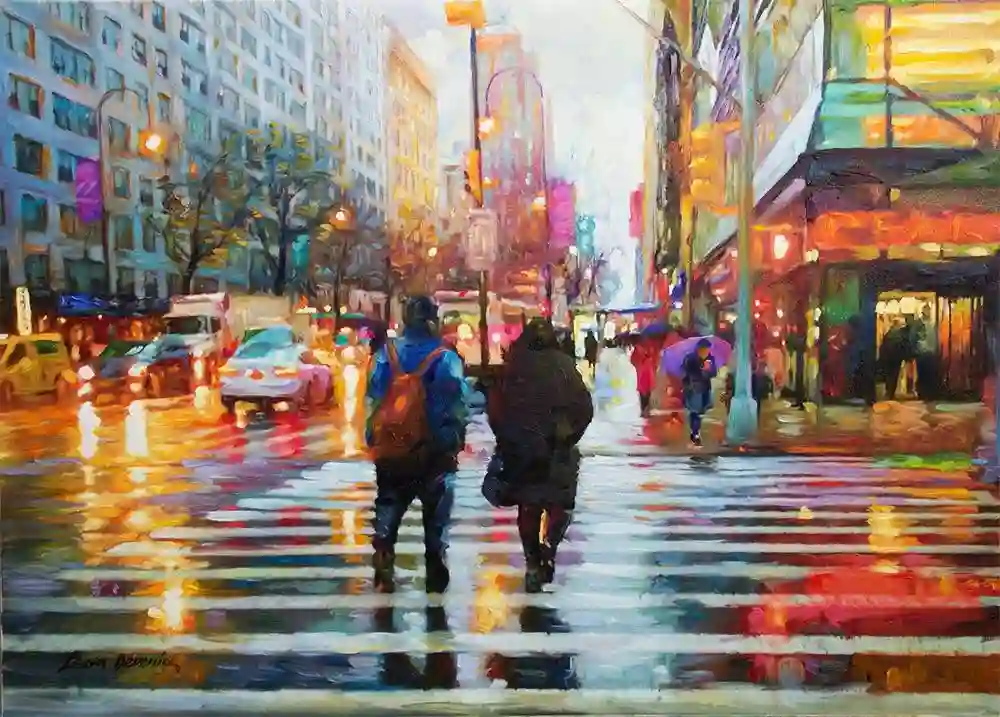Color is one of the most powerful elements in visual art, and understanding color theory is essential for creating stunning and captivating oil paintings. Whether you’re a beginner or an experienced artist, a solid grasp of color theory can elevate your work to new heights. In this article, we’ll delve into the fundamentals of color theory and how to use it effectively in your oil painting.
1. The Color Wheel:
The color wheel is a fundamental tool in understanding color relationships. It consists of primary colors (red, blue, and yellow), secondary colors (orange, green, and purple), and tertiary colors (mixtures of primary and secondary colors). The color wheel helps you visualize how colors are related and can be harmoniously combined.
2. Primary Colors:
Primary colors are the foundation of all other colors. In traditional color theory, red, blue, and yellow are considered primary colors because they cannot be created by mixing other colors. They are used to create all other colors on the color wheel.
3. Secondary Colors:
Secondary colors are created by mixing two primary colors together. These colors are orange (red + yellow), green (yellow + blue), and purple (red + blue). Secondary colors are located between the primary colors on the color wheel.
4. Tertiary Colors:
Tertiary colors are created by mixing a primary color with a neighboring secondary color. For example, mixing red (primary) with orange (secondary) creates a tertiary color known as red-orange. Tertiary colors provide a wide range of shades and variations.
5. Color Harmony:
Color harmony refers to the pleasing arrangement of colors in an artwork. There are several color harmonies to consider:
- Complementary Colors: Complementary colors are opposite each other on the color wheel, such as red and green or blue and orange. Using complementary colors can create strong contrast and visual interest.
- Analogous Colors: Analogous colors are adjacent on the color wheel, like red, orange, and yellow. Using analogous colors creates a sense of harmony and unity in your paintings.
- Triadic Colors: Triadic color schemes involve selecting three evenly spaced colors on the color wheel, such as red, blue, and yellow. Triadic schemes offer a balanced and vibrant look.
6. Warm and Cool Colors:
Colors can be categorized as warm or cool based on their visual temperature:
- Warm Colors: Warm colors, such as red, orange, and yellow, evoke feelings of warmth, energy, and passion. They can create a sense of vibrancy and excitement in your paintings.
- Cool Colors: Cool colors, like blue, green, and purple, convey a sense of calm, tranquility, and serenity. They can be used to create a soothing and peaceful atmosphere.
7. Value and Intensity:
In addition to hue (color), value and intensity are essential aspects of color. Value refers to the lightness or darkness of a color, while intensity refers to its purity or saturation. Understanding how to manipulate value and intensity can add depth and dimension to your paintings.
8. Color Mixing:
Oil paints allow for extensive color mixing possibilities. Experiment with mixing primary colors to create a wide range of secondary and tertiary colors. Remember that oil paints can be layered and glazed to achieve subtle shifts in color and depth.
9. Color Temperature:
Consider the color temperature of your light source when painting. Different lighting conditions can influence how colors appear. For example, natural daylight may reveal warm and cool tones, while indoor lighting can have a more neutral or warm cast.
10. Color Psychology:
Colors evoke emotional responses and convey messages in your artwork. Red can symbolize passion or danger, while blue can represent calm or melancholy. Use color psychology to convey the mood and message you want to express in your oil paintings.
Conclusion:
Understanding color theory is essential for creating stunning oil paintings that captivate viewers with their harmonious and expressive use of color. Whether you’re aiming for vibrant and energetic compositions or serene and contemplative landscapes, color theory provides the foundation for your artistic vision.
Experiment with different color harmonies, explore the emotional impact of warm and cool colors, and master the art of color mixing. Remember that color theory is not just a set of rules but a versatile toolkit that allows you to convey your unique perspective and emotions through your art.
So, pick up your brushes, select your colors, and let the principles of color theory guide you on your journey to creating stunning and visually engaging oil paintings.








